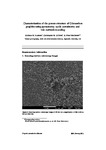Characterisation of the porous structure of Gilsocarbon graphite using pycnometry, cyclic porosimetry and void-network modeling
| dc.contributor.author | Laudone, Giuliano Maurizio | |
| dc.contributor.author | Gribble, CM | |
| dc.contributor.author | Matthews, Peter | |
| dc.date.accessioned | 2014-04-08T09:57:47Z | |
| dc.date.accessioned | 2014-04-08T09:58:23Z | |
| dc.date.accessioned | 2014-05-15T07:52:52Z | |
| dc.date.accessioned | 2014-05-15T07:53:16Z | |
| dc.date.available | 2014-04-08T09:57:47Z | |
| dc.date.available | 2014-04-08T09:58:23Z | |
| dc.date.available | 2014-05-15T07:52:52Z | |
| dc.date.available | 2014-05-15T07:53:16Z | |
| dc.date.issued | 2014-07 | |
| dc.identifier.issn | 0008-6223 | |
| dc.identifier.issn | 1873-3891 | |
| dc.identifier.uri | http://hdl.handle.net/10026.1/3022 | |
| dc.description | file: :C$$:/pdf/1-s2.0-S000862231400164X-main.pdf:pdf | |
| dc.description.abstract |
The cores of the fourteen Advanced Gas-cooled nuclear Reactors (AGRs) within the UK comprise Gilsocarbon graphite, a manufactured material surrounded predominantly by CO2 at high pressure and temperature to provide heat exchange. The intense ionising radiation within the reactors causes radiolytic oxidation, and the resulting mass loss is a primary factor in determining reactor lifetime. The void structure of the porous Gilsocarbon graphite affects the permeability and diffusion of the carbon dioxide, and the sites of oxidation. To model this void structure, the porosities and densities of ten virgin Gilsocarbon graphite samples have been measured by powder and helium pycnometry. For comparison, results are also presented for highly ordered pyrolytic graphite (HOPG), and a fine-grained Ringsdorff graphite. Samples have been examined at a range of magnifications by electron microscopy. Total porosities and percolation characteristics have been measured by standard and cyclic mercury porosimetry up to an applied mercury pressure of 400MPa. Inverse modelling of the cyclic intrusion curves produces simulated void structures with characteristics which closely match those of experiment. Void size distributions of the structures are presented, together with much Supplementary Information. The simulated void networks provide the bases for future simulations of the radiolytic oxidation process itself. | |
| dc.format.extent | 61-70 | |
| dc.language | en | |
| dc.language.iso | en | |
| dc.publisher | Elsevier | |
| dc.relation.replaces | http://hdl.handle.net/10026.1/2975 | |
| dc.relation.replaces | 10026.1/2975 | |
| dc.relation.replaces | http://hdl.handle.net/10026.1/2976 | |
| dc.relation.replaces | 10026.1/2976 | |
| dc.relation.replaces | http://hdl.handle.net/10026.1/3021 | |
| dc.relation.replaces | 10026.1/3021 | |
| dc.title | Characterisation of the porous structure of Gilsocarbon graphite using pycnometry, cyclic porosimetry and void-network modeling | |
| dc.type | journal-article | |
| dc.type | article | |
| plymouth.author-url | https://www.webofscience.com/api/gateway?GWVersion=2&SrcApp=PARTNER_APP&SrcAuth=LinksAMR&KeyUT=WOS:000335096300007&DestLinkType=FullRecord&DestApp=ALL_WOS&UsrCustomerID=11bb513d99f797142bcfeffcc58ea008 | |
| plymouth.volume | 73 | |
| plymouth.publisher-url | http://www.sciencedirect.com/science/article/pii/S000862231400164X | |
| plymouth.publication-status | Published | |
| plymouth.journal | Carbon | |
| dc.identifier.doi | 10.1016/j.carbon.2014.02.037 | |
| plymouth.organisational-group | /Plymouth | |
| plymouth.organisational-group | /Plymouth/Faculty of Science and Engineering | |
| plymouth.organisational-group | /Plymouth/Faculty of Science and Engineering/School of Geography, Earth and Environmental Sciences | |
| plymouth.organisational-group | /Plymouth/REF 2021 Researchers by UoA | |
| plymouth.organisational-group | /Plymouth/REF 2021 Researchers by UoA/UoA07 Earth Systems and Environmental Sciences | |
| plymouth.organisational-group | /Plymouth/Users by role | |
| plymouth.organisational-group | /Plymouth/Users by role/Academics | |
| dcterms.dateAccepted | 2014-02-11 | |
| dc.identifier.eissn | 1873-3891 | |
| dc.rights.embargoperiod | Not known | |
| rioxxterms.versionofrecord | 10.1016/j.carbon.2014.02.037 | |
| rioxxterms.licenseref.uri | http://www.rioxx.net/licenses/all-rights-reserved | |
| rioxxterms.licenseref.startdate | 2014-07 | |
| rioxxterms.type | Journal Article/Review |



